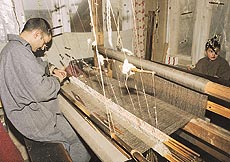

 
 


 
 
|
Is the shahtoosh
shawl industry dying ?
By Ehsan
Fazili
EVER since Egyptian ruler Khedive
presented a Kashmiri shawl to Napoleon’s wife,
Josephine, these shawls became fashionable. The shawls
continue to enjoy a distinct place in Kashmiri
handicrafts with shahtoosh shawls as one of the
specialities of the state. Thousands of men and women
associated with spinning, weaving and trade of shahtoosh
shawls are facing an uncertain future on account of a
world-wide ban on its trade. The ban, however, is not
applicable in Jammu and Kashmir, particularly the valley,
where the weavers and traders are dependent on this
age-old handicraft for their living. According to
environmentalists, antelopes (the Tibetan species is
known as Chiru — Pantholope Hodgsoni) are killed to
procure shahtoosh wool for these shawls. But
manufacturers, traders and the Jammu and Kashmir
government refute these claims, saying that the antelopes
are not killed. They say that the delicate wool is
procured from bushes and shrubs in Tibet as these wild
animals rub and brush against them in search of food at
an altitude of over 24,000 ft. from the sea level.
 A
number of shahtoosh shawl traders from Kashmir
were arrested from various cities of the country last
year, following the imposition of an international ban on
shahtoosh shawls. A large number of these shawls
were seized by the police. At least 45 shahtoosh
shawls were also confiscated in Hong Kong following a
court order under which some of the traders were fined. A
number of shahtoosh shawl traders from Kashmir
were arrested from various cities of the country last
year, following the imposition of an international ban on
shahtoosh shawls. A large number of these shawls
were seized by the police. At least 45 shahtoosh
shawls were also confiscated in Hong Kong following a
court order under which some of the traders were fined.
Five lakh Kashmiris are
associated with the manufacture and sale of shawls in
Kashmir, and most of them only deal with shahtoosh
shawls. Though the raw material comes from outside the
state, there are no other craftsmen better than
Kashmiris, who are known world-wide for their expertise
in weaving.
Several weavers in
Srinagar earn their livelihood from this cottage
industry. "We weave these shawls for the wholesale
dealers, who supply it to the outside world", said
Fayaz Ahmad Mir, a weaver who has a loom in his house in
Narwana locality, Srinagar. He clarifies that antelopes
are not killed to procure the wool. "It is a false
propaganda against those dependent on this trade",
he adds. An official at the Directorate of Handicrafts
Department of Jammu and Kashmir Government corroborated
the statement by asserting that the "antelopes are
not killed to procure the special wool. The wool is
collected from bushes in the higher reacches in
summer".
Kalimullah, a senior
member of the Shahtoosh Manufacturers and Traders
Association mainted that so far there was no evidence
that antelopes were being killed. He added that if any
evidence was provided in support of this belief, they
would quit the trade. "If the antelope gets killed
to procure the wool, there will come a time when the
species will vanish and we will have no wool. The trade
has been going on for several hundred years now. If
antelopes were being killed, the shahtoosh shawl
industry would not have existed today", Fayaz Ahmad
Mir said.
Even the Jammu and
Kashmir Chief Minister, Dr Farooq Abdullah, has been
against the imposition of the ban on shahtoosh
trade. "I do not want people to die for want of shahtoosh
.... I want them to survive ....Shahtoosh will
continue to be sold in Kashmir", he stated recently.
He has approached the Union Ministry for taking adequate
measures for safeguarding the interests of those
connected with the trade.
The 60-year-old Ghulam
Mohammad Mir, another artisan from Narwara locality, has
been associated with the craft for more than four
decades. He along with his two sons and a couple of other
weavers weave shahtoosh shawls in his house. A
number of looms have been installed in one portion of his
tin-roofed kutcha house. "I want this trade to
flourish for this is my only source of livelihood",
Ghulam Mohammad Mir said, while reacting to the reported
ban on shahtoosh trade. He is happy over the
modification of various tools used for weaving shawls.
His son, Fayaz Ahmad, said the loom that weaves four shahtoosh
shawls (two metre each) takes them at least three
months for completion of the work. They get Rs 4,000 for
the weaving. "We have been demanding more money from
the dealers, but there is no response as the government
department concerned does not come to our aid", he
adds.
Each shawl costs at
least Rs 20,000. With embroidery work the cost can go up
to Rs 80,000. The shahtoosh shawls weigh about 100
to 160 gms and are so delicate that they easily pass
through a finger ring worn by women.
Shoaukat Ahmad,
30-year-old son of Ghulam Mohammad Mir, has been in this
trade since his early teens. But he does not want his
five-year-old son Umar, to adopt this craftsmanship. He
has got him admitted to a private school, and wants him
to be better educated and seek a white-collar job as this
trade has neither offered him security nor economic
status. "The plight of shawl weavers in Kashmir has
been equally bad ever since the industry in Kashmir was
given a boost. Their condition is bad and apparently
hopeless", wrote a British author on Kashmir weavers
about a hundred years ago. The plight continues to be the
same, but one hopes that the unique shawl industry of
Kashmir continues to survive, and flourish.
|

![]()

